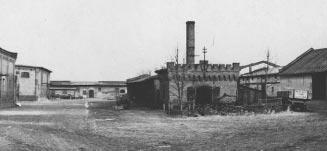
|
The rainbow never sets
your fingers into this auger, or they can be cut off in no time!"
We peeped through a window of the drier. There, on about 20 meters long and two meters broad sheets of canvas the starch was travelling slowly from one layer to the next, about 15 layers in all. By the time it had travelled to the bottom layer, it was dry. Then the starch was sifted through a fine silk screen and bagged into 100 kg bags, sealed and stored, ready for shipment.
"That was interesting, for sure," said Helmut. "I liked the machine room best with all those moving parts."
"Oh, I forgot to show you, that is also where the generator is housed. We make our own electricity. There is a column of batteries which are storing electricity, and when we or Opa and Oma are putting our lights on, the power comes from here, even when the machines are not going."
"How can that be?" he wanted to know. "Didn't our teacher tell us that to produce a current, a turbine must constantly be turning?"
"Yes, that's correct, but we are producing D.C., not A.C. This is a much cheaper way of producing electricity."

|
Farm Yard, Cowshed on left, horses stables next. In centre the Forge and Carpenter's shop.
Then I took Helmut through our farm yard, starting with the cow shed on our left. I told him that we had about 100 milking cows, that they were milked twice a day by a team of about 15 women, mostly the wives of the workers, and that milking time was usually from 4 to 5 in the afternoon, and then again 4 to 5 in the morning.
"That's very early. Isn't it still dark then." "Of course, but that's why we also need electricity here. After the women have milked a cow, they bring the full bucket here into the cool room where the milk filter stands. They pour it there into that container at the top. Then it runs through the filter and the cooler and is collected
40